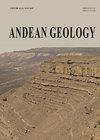Lower Ordovician calcareous microfossils from the San Juan Formation, Argentina: a new type of calcitarch and its paleoenvironmental implications
IF 1.2
4区 地球科学
Q3 GEOLOGY
引用次数: 0
Abstract
The calcareous microfossils present in the Ordovician and Silurian carbonate successions around the world are limited to few studies and their biological affinities and environmental preferences remain indefinite. In the carbonate Ordovician San Juan Formation from the Cerro La Chilca section, a group of calcareous microfossils was recognized and, based on their size, they are included in the calcitarch classification. Two types of calcitarchs have been recognized, Type-III calcitarch: large spheres with a thin to medium wall (diameter ~250 μm), and Type-0 calcitarch: small spheres with a thin wall (diameter ~80 μm). The carbonate microfacies analysis of the lower part of the San Juan Formation allowed defining five successive microfacies: burrowed bioclastic wackestone (M1), peloidal intraclastic packstone-grainstone (M2), intraclastic floatstone (M3), intraclastic wackestone-packstone (M4) and bioclastic boundstone (M5). These microfacies are interpreted to range from shallow subtidal facies below wave action to shoal and reef facies. It is possible to infer that the recovered calcitarchs show variations in size in relation to the facies that contain them. The calcitarchs recognized in wackestone-type facies are the Type-0 calcitarch and those recovered from the packstone-grainstone facies are the Type-III calcitarch. The calcitarch sizes variation probably is related to a gradual increase of energy within a shallow subtidal environment. Occurrences of calcitarchs within the Floian Oepikodus evae-O. intermedius conodont zone extends their fossil record into the Early Ordovician.阿根廷圣胡安组下奥陶统钙质微体化石:一种新型钙质沥青及其古环境意义
奥陶系和志留系碳酸盐岩层序中存在的钙质微化石在世界范围内研究较少,其生物亲和性和环境偏好仍然不确定。在Cerro La Chilca剖面的奥陶系San Juan组中发现了一组钙质微化石,并根据其大小将其纳入钙质分类。可识别出两种类型的方解石:iii型方解石:薄壁至中壁大球体(直径~250 μm); 0型方解石:薄壁小球体(直径~80 μm)。通过对圣胡安组下部碳酸盐岩微相的分析,确定了5个连续的微相:洞状生物碎屑碎屑砾岩(M1)、球囊状碎屑内砾岩-颗粒岩(M2)、碎屑内浮岩(M3)、碎屑内碎屑-砾岩(M4)和生物碎屑边界岩(M5)。这些微相被解释为从波浪作用下的浅潮下相到浅滩和礁相。由此可以推断,所发现的方解石的大小随其所含相的不同而不同。微晶岩型相中发现的方解石为0型方解石,包岩-颗粒岩相中发现的方解石为ⅲ型方解石。钙质大小的变化可能与浅层潮下环境中能量的逐渐增加有关。Floian oepiikodus中钙质的出现。中牙形石带的化石记录延伸至早奥陶世。
本文章由计算机程序翻译,如有差异,请以英文原文为准。
求助全文
约1分钟内获得全文
求助全文
来源期刊

Andean Geology
地学-地质学
CiteScore
3.90
自引率
0.00%
发文量
17
审稿时长
>12 weeks
期刊介绍:
This journal publishes original and review articles on geology and related sciences, in Spanish or English, in three issues a year (January, May and September). Articles or notes on major topics of broad interest in Earth Sciences dealing with the geology of South and Central America and Antarctica, and particularly of the Andes, are welcomed.
The journal is interested in publishing thematic sets of papers and accepts articles dealing with systematic Paleontology only if their main focus is the chronostratigraphical, paleoecological and/or paleogeographical importance of the taxa described therein.
 求助内容:
求助内容: 应助结果提醒方式:
应助结果提醒方式:


